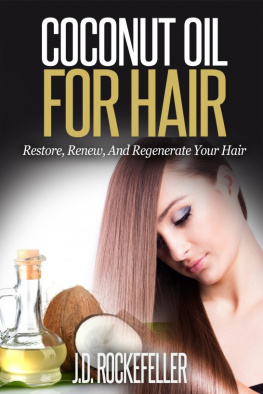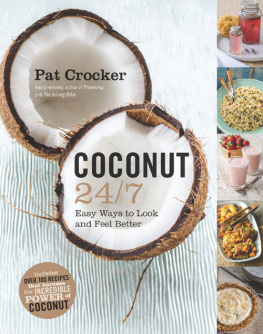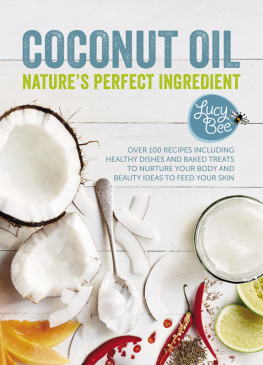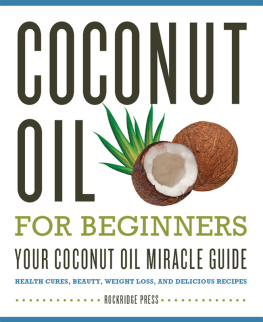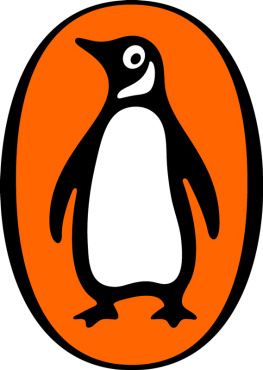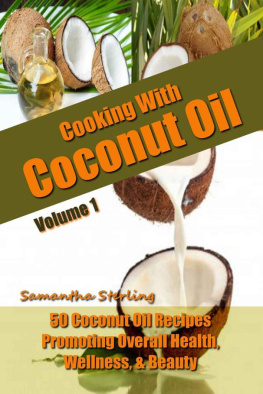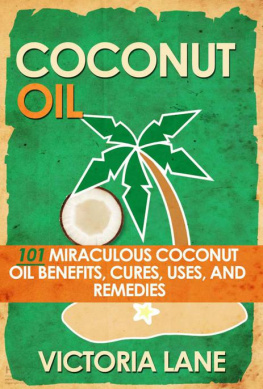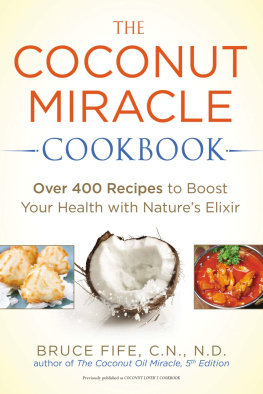Coconut Oil-Natures Wonder Cure
HowCoconut Oil Revitalizes The Body
By:Jerrod Heyd
Table of Contents
Publishers Notes
Disclaimer
This publication is intended toprovide helpful and informative material. It is not intended to diagnose,treat, cure, or prevent any health problem or condition, nor is intended toreplace the advice of a physician. No action should be taken solely on thecontents of this book. Always consult your physician or qualified health-careprofessional on any matters regarding your health and before adopting anysuggestions in this book or drawing inferences from it.
The author and publisherspecifically disclaim all responsibility for any liability, loss or risk,personal or otherwise, which is incurred as a consequence, directly orindirectly, from the use or application of any contents of this book.
Any and all product namesreferenced within this book are the trademarks of their respective owners. Noneof these owners have sponsored, authorized, endorsed, or approved this book.
Always read all informationprovided by the manufacturers product labels before using their products. Theauthor and publisher are not responsible for claims made by manufacturers.
2014
Manufactured in the United Statesof America
Dedication
This book is dedicated to myfamily. They have taught me the true value of a supportive family.
Chapter 1- Coconut Oil- What Is It and Where Did It Originate?
Coconutoil was used for many years by our ancestors. However, its recent comeback isdue to the discovery of its versatility and multiple uses, such as formedicinal purposes, as a health food, in soaps and cosmetics, and for use inindustrial products. Containing high amounts of saturated fat, coconut oil hasa shelf-life of approximately two years without turning rancid or spoiling.

Theflesh of the coconut produces a white semi-solid fat which is edible by humansand some animals. After the coconuts have been harvested from coconut palmtrees, the oil is extracted from the meat of mature coconuts. Proper harvestingis crucial for proper processing, and coconuts should be picked when they arebetween 2 - 20 months of age. Mature coconuts only yield a little more than 10%of extracted oil.
Processing
Dryor wet processing can be used to extract the oil from coconuts. Dry processinginvolves removing the meat from the shell and drying it out in the sun withheat from a fire or using a kiln. This process produces a high-fiber proteinmash called copra which is pressed or liquefied using a detergent-type solvent.Copra is inedible by humans but may be fed to animals such as cows, sheep,goats, antelopes, giraffes, and okapis. Dry processing is not used as often dueto the risk of spoilage and infestation of pests.
Theraw coconut is used in wet processing, and creates a creamy paste of the oiland water. Several processes are used to extract the oil, such as rotating thepaste in a centrifuge to separate the components needed or applications of coldor heat, salts, acids, or enzymes. Some oil is lost in wet processing and has ahigh manufacturing cost due to the technology and equipment required in theprocessing.
Usesof Coconut Oil
Coconutoil is excellent for use is cooking, for industrial use, personal use, and formedicinal purposes.
Cooking
Usedfor frying, baking, and sauting foods and in South Asian cuisine, refinedcoconut oil made from copra (processed dried coconut meat) normally does nothave any taste or smell. While there is no industry standard regarding virgincoconut oil (VCO), a common characteristic is that it should be made with freshcoconut meat instead of dried, and chemicals or excessive heat processes arenot used in processing. VCO is known for its sweeter, nuttier flavor thanrefined coconut oil. Health-conscious people and vegetarians prefer to usecoconut oil in cooking. It is also used in the following foods:
- Baked goods and pastries
- Sauting vegetables and sauces
- Movie theater popcorn
- Non-dairy creamers
IndustrialUse
Sincecoconut oil can tolerate high temperatures, has a high viscosity (fluiditymovement), and low combustion, it has been used to make diesel engine fuel.However, if it doesn't meet certain industrial standards, it can clog orcarbonize in an unmodified engine. Samoa, the Philippines, and other tropicalareas use coconut oil as fuel for cars, trucks, and other transportation. Otheruses include:
- To power generators
- Engine lubricants
- Transformer oil
- Herbicides
- Surfactants, which allows the liquid to spread more
PersonalUses
Inaddition to uses in cooking and industry, coconut oil is used for moisturizingdry skin and hair; can be used as a sexual lubricant; was burned in oil lampsin the Indian culture; and is the base ingredient for many types of soap.
MedicinalPurposes
Knownfor its healing properties and nutritional benefits, some Pacific islandersconsider coconut oil a cure-all for various ailments. Full of vitamins andminerals, coconut oil has been called "the earth's healthiest oil"because it is unique in its composition. In 1954, there was major concern thatcoconut oil was ruining the health of Americans due to the high saturated fatcontent, and claims were made that it was blocking arteries and causing heartdisease in adults. This sparked an interest in the oil, and modern medicine hasnow proven that even though it is a saturated fat, coconut oil is different instructure and behaves differently in the body than other oils. It is nowconsidered a "super fat" with more health and medicinal benefits thanpreviously believed. It has been proven to protect the body against diabetes,cancer, osteoporosis, tooth decay, and infections.
Originof Coconut Oil
Coconutoil is obtained from the seed of the palm tree, which is the coconut, or cocosnucifera. The use of coconut oil has been documented throughout history formore than 3900 years as a food source and for medicinal purposes. Some of thefirst documentation was written in Sanskrit as early as 1500 B.C. Its useoriginated in the tropics of South and Central America, Africa, India, andthroughout Asia. While coconut oil was believed to have originated in theWestern Pacific islands and India, coconuts traveled across the ocean to otherislands and countries on the ocean currents. Even after floating in the oceanfor several months, coconut seeds are still able to germinate. It is called thefruit of the gods because every part of the coconut tree or seed can be usedfor a specific purpose.
Usedall over the world, coconut oil was used in tropical countries as hair tonic,skin moisturizers, soap, and body oils. In India, it was used as the maincooking oil. After WWII, it was used as margarine and coconut butter. Today,coconut oil is among the 9 top oils that are traded internationally and isproduced in Indonesia, the Philippines, and India. The world coconut oil marketis valued at around 20 million dollars.
Thecoconut palm has been called the Tree of Life for centuries. The oil has beenused for food, medicine, and skin care. It is now used as a part of a healthydiet and is an essential ingredient in a multitude of body and hair careproducts. It is a natural antioxidant and is cholesterol free. The discovery ofthe many beneficial properties of coconut oil will change lives for the good.
Chapter 2- Extra Virgin and RegularCoconut Oil- How Are They Different?
Coconutoil has been used in the tropics for thousands of years, but it is starting toget a lot of attention. Its health benefits are becoming obvious. Coconut oilcomes in available in two forms: unrefined and refined.
Next page

